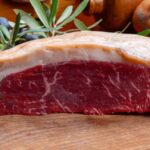Thanksgivings at his grandmother’s home in the Bronx were a special time for David Glick. Amidst the classic American dishes like turkey, there was always yapsuk, a dish David fondly remembers as “a potato kugel or latke on steroids – hearty, delicious, and perfect with turkey gravy.” This unique recipe was so deeply ingrained in the Glick family’s traditions that David’s brother, Aaron, even penned a poem about it during his middle school years, highlighting its significance in their lives.
The origins of this beloved yapsuk recipe can be traced back to Poland, the homeland of David’s grandmother, Gussie. She spent her childhood in a shtetl in Klobuck, where yapsuk was more than just a family dish; it was a communal experience. Prepared in a nearby communal oven, it was collected after synagogue on Saturdays and served for lunch alongside cholent, another staple of traditional Jewish cuisine. Gussie reminisced about these Saturdays in a family interview with Aaron, recalling, “Shabbos afternoon my parents had sex. They chased us out so that they could have sex,” painting a vivid picture of life in her childhood home.
However, these peaceful Saturday traditions were abruptly shattered when World War II erupted during her sixteenth year. The war tragically tore her family apart, and Gussie endured the horrors of multiple concentration camps, ultimately finding herself in Bergen-Belsen, where she witnessed liberation in 1945. After the war’s end, she reconnected with Abe Glick, who had also grown up in Klobuck. Together, they embarked on a new chapter, immigrating to the United States, marrying, and settling in the Bronx, bringing with them the echoes of their past and the seeds of new traditions.
“My grandfather was the slipcover king of New York,” David recounts, describing their early years in America. Abe and Gussie worked side-by-side, sewing fabric and plastic furniture covers, building a life in a new country. Despite establishing themselves in America, Gussie rarely spoke about her harrowing experiences in Europe until later in life. Instead, she poured her love and nurturing spirit into her grandchildren. Yapsuk, a dish adored by David and his brother, became a frequent expression of her love, gracing not only Thanksgiving tables but also Passover and other family gatherings.
As David approached adulthood, around 18 years old, he felt a strong desire to preserve the yapsuk recipe. “A lot of our family traditions were deleted from our collective memory except for one,” he explained, emphasizing the urgency he felt to prevent yapsuk from being lost to time. He asked Gussie to prepare it, diligently documenting her every step on a note card. At that time, yapsuk was virtually unknown outside of their family circle. Online searches yielded almost no results. It was only at Gussie’s funeral that a rabbi mentioned it sounded similar to yapchik, a potato kugel variation incorporating meat, suggesting a possible ancestral link to yapsuk.
To ensure the family recipe’s enduring legacy, David took a step into the digital age. When he first created a Gmail account years ago, he meticulously transcribed the yapsuk recipe there, ensuring, as he says, “so it would be there in perpetuity.” This act of digital preservation not only safeguards a cherished family tradition but also offers a glimpse into the rich tapestry of Jewish Food history, highlighting how dishes like yapsuk carry stories of resilience, heritage, and love across generations. Yapsuk stands as a testament to the power of food to connect us to our past and nourish our future, a true gem in the world of Jewish cuisine.

